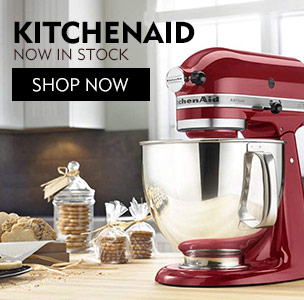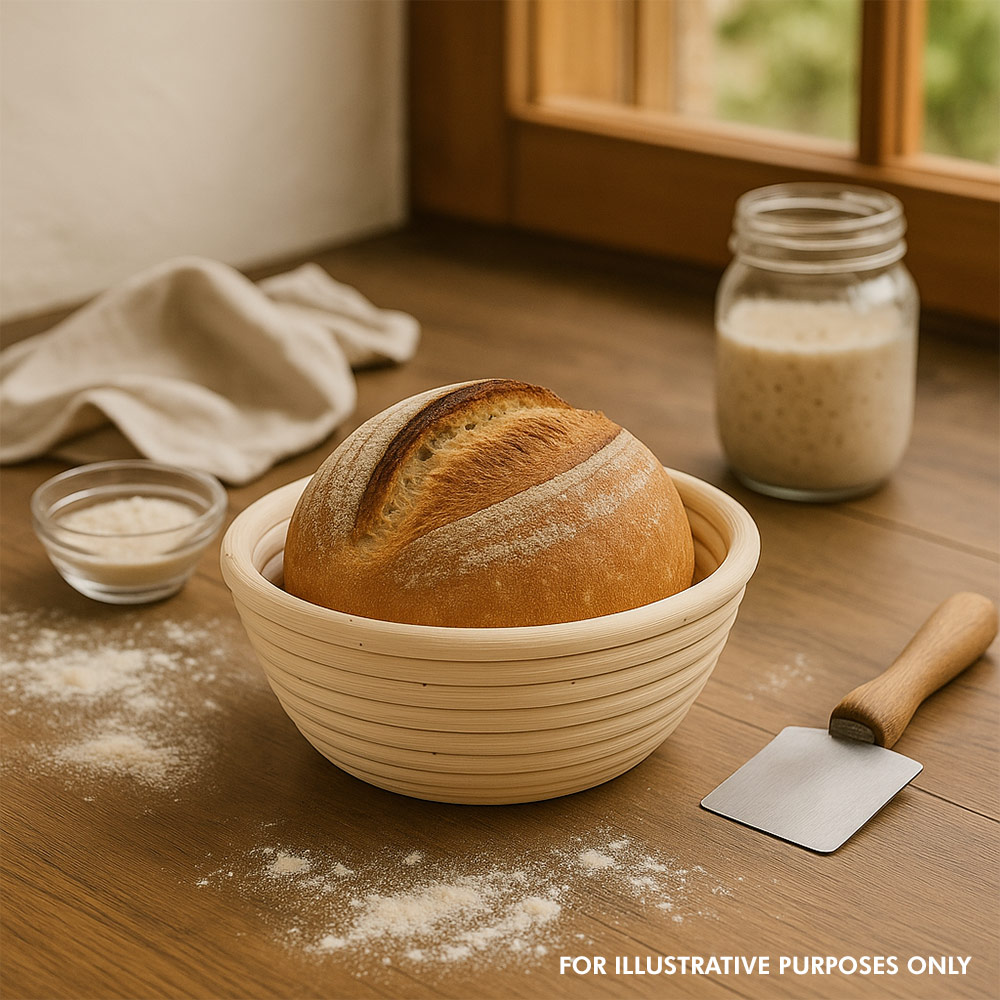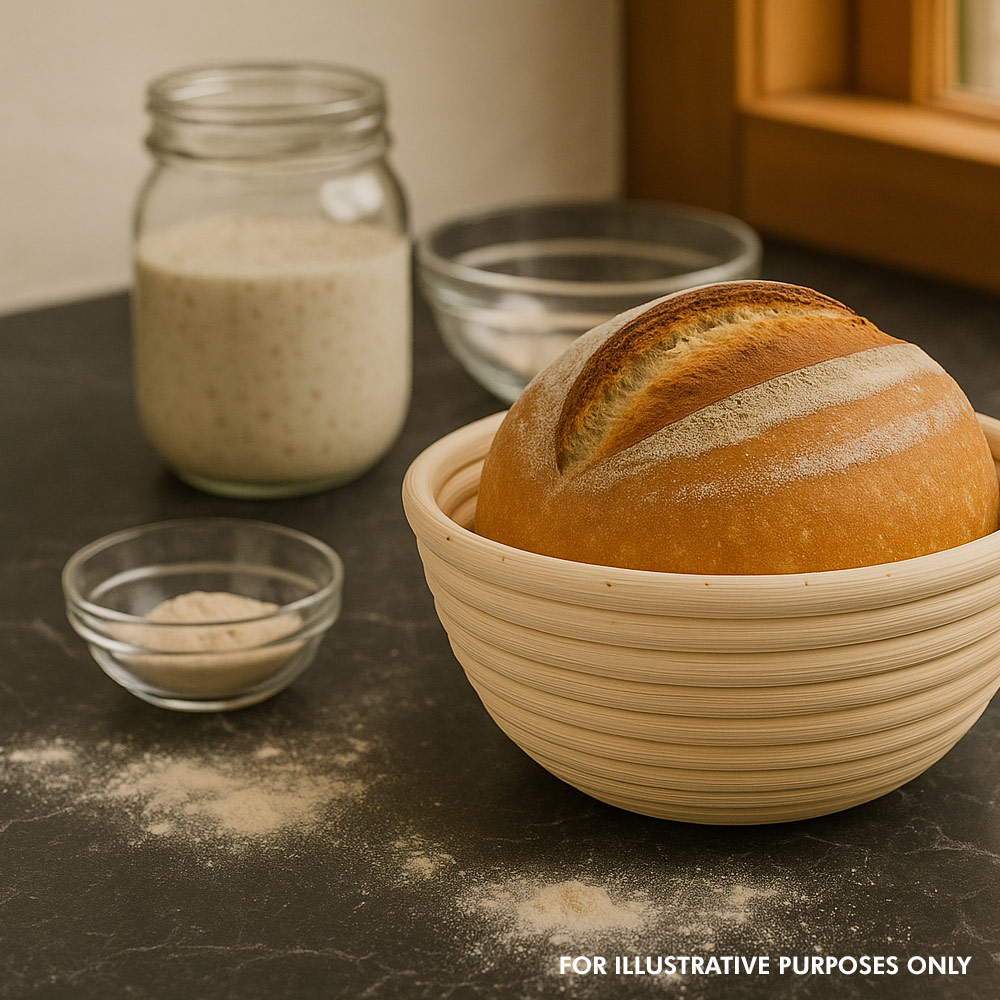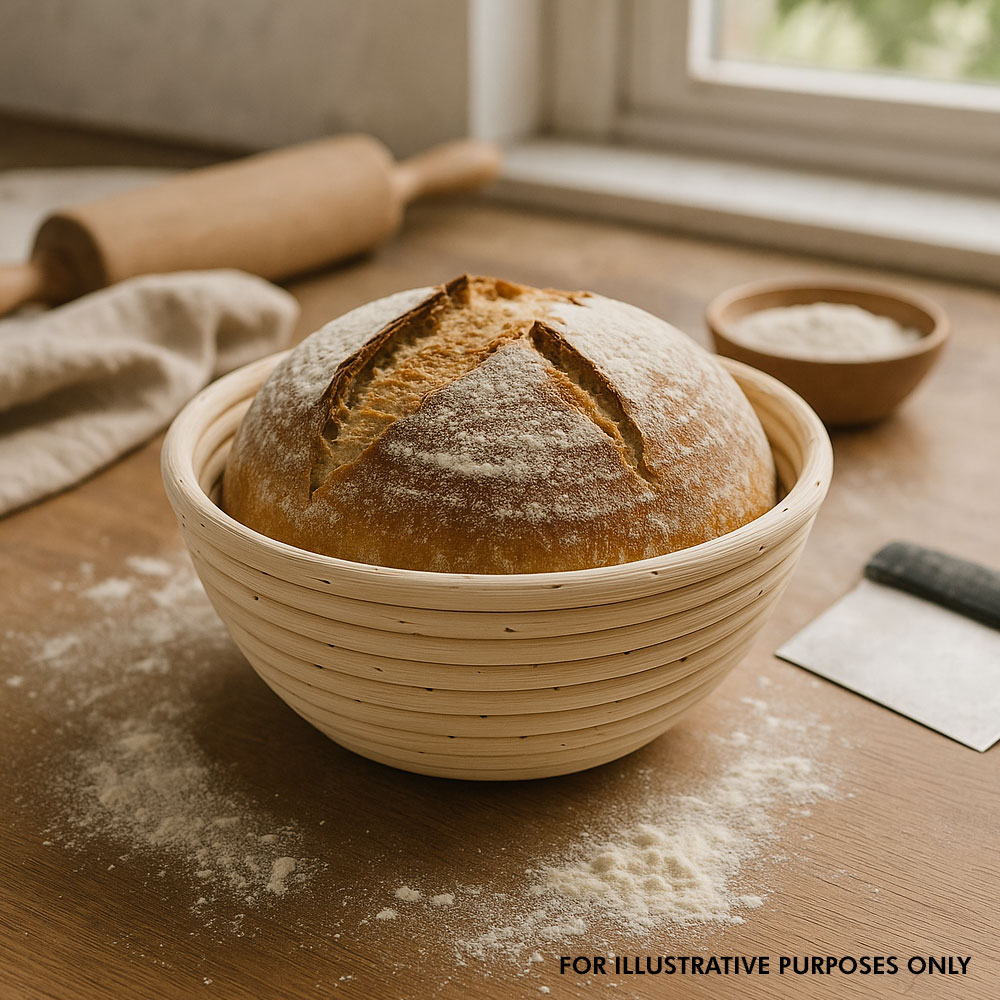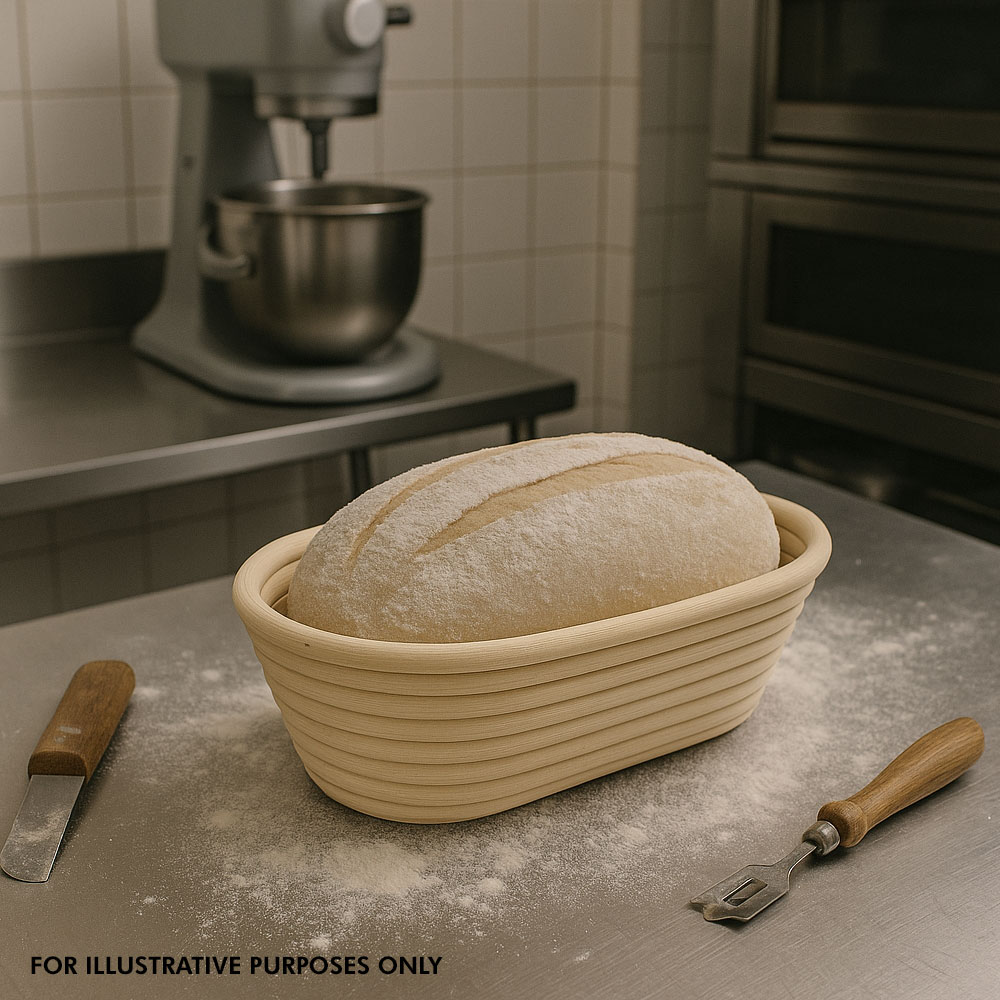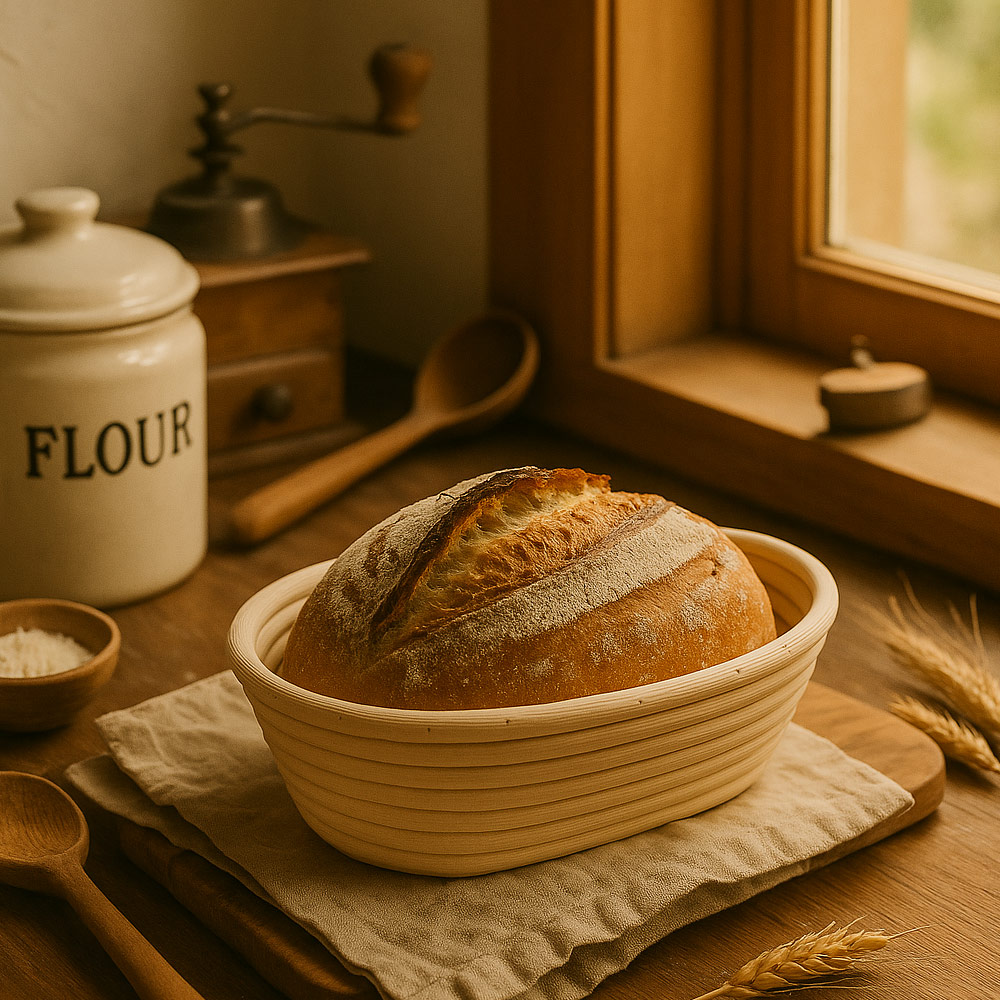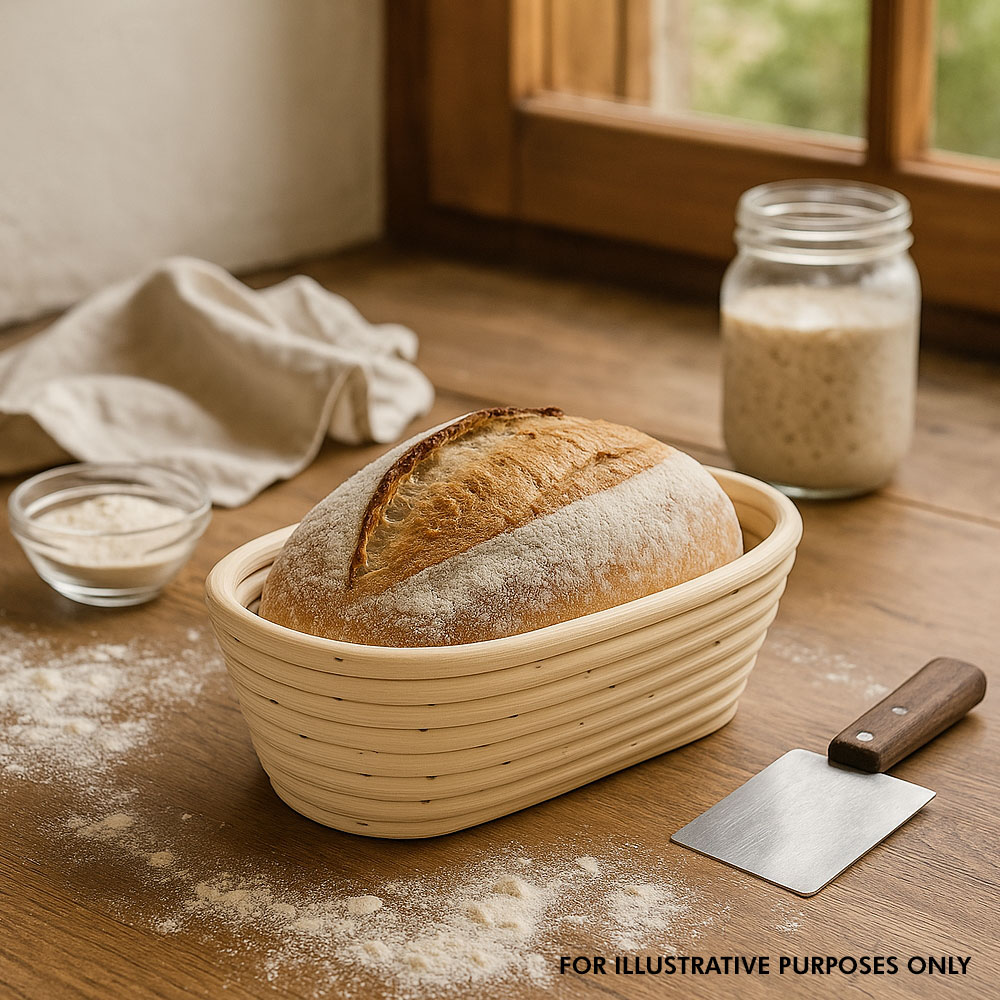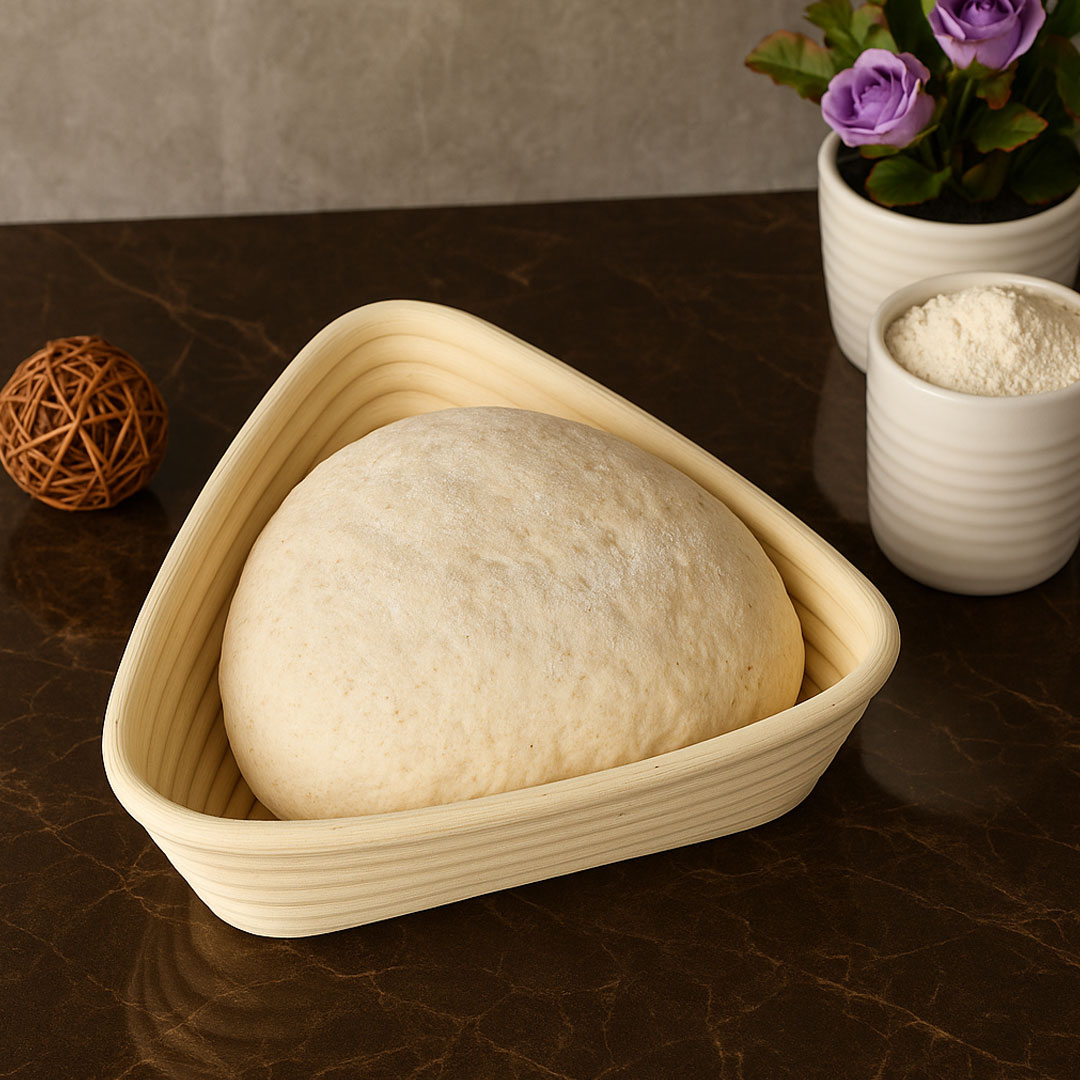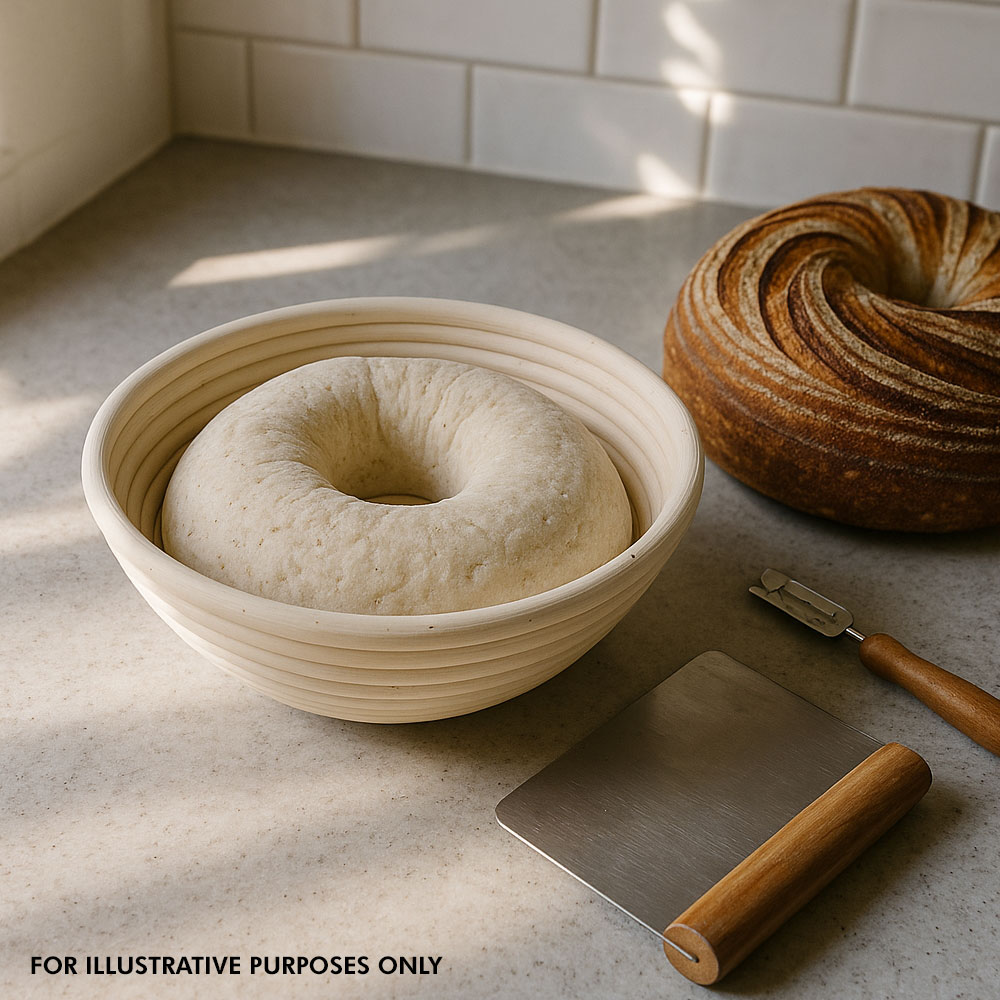Banneton Basket Buying Guide
08-06-2025
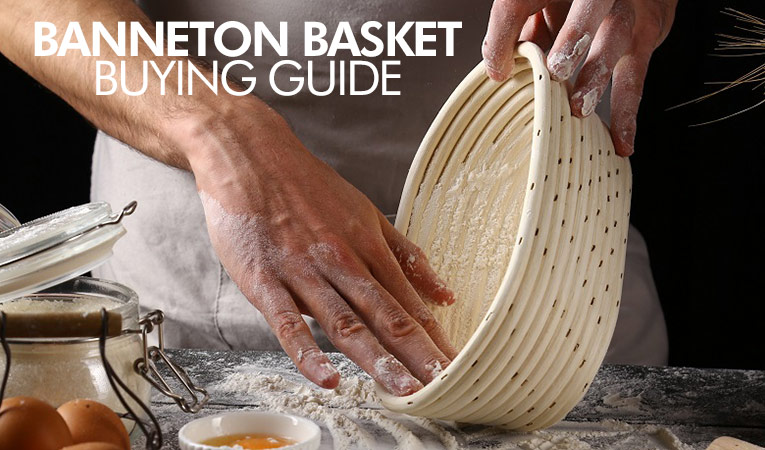
Baking artisan bread at home is a satisfying blend of skill, patience, and the right tools. For bakers aiming to achieve that crisp crust and open crumb typical of professional loaves, using a Banneton Basket can make a remarkable difference. This traditional proofing tool is designed to support dough during the final rise, giving structure, shape, and surface texture that enhance the final baked result. Whether you are just starting out with sourdough or refining your approach, having the right setup can influence every bake.
The final proof is often the most delicate phase in bread making, and choosing the right container for this step is essential. A proofing basket made of natural rattan or cane helps maintain the dough’s form while allowing excess moisture to escape. This encourages even fermentation and helps produce a crisp crust when baked. The signature spiral or lined patterns left on the surface add to the visual appeal and professional character of your loaf. Unlike metal or plastic bowls, these baskets are breathable, allowing the dough to develop both inside and out.
This comprehensive Banneton Basket Buying Guide has been created to help you explore the range of baskets available and choose the best one for your baking needs. From understanding shapes and sizes to learning how to prepare and care for your basket, the sections ahead are structured to guide beginners and seasoned bakers alike. With the right proofing basket, you can consistently turn out breads that are both beautiful and delicious. Let us begin by understanding what a Banneton or proofing basket truly is and why it has become such a staple in artisan kitchens.
What is a Banneton Basket?
A Banneton Basket is a traditional tool used in artisan bread baking to support the dough during its final rise before baking. Also known as a proofing basket, it is typically made from natural rattan or cane and is shaped to hold bread dough in a compact, structured form. These baskets are especially valued in sourdough baking, where structure, surface pattern, and controlled moisture absorption all play important roles in the final result.
Unlike regular bowls or containers, a proofing basket is designed with a coiled or ridged interior that lightly imprints patterns onto the dough surface as it proofs. These patterns bake into the crust, giving artisan loaves their distinctive rustic appearance. The basket’s material is breathable, allowing air to circulate freely around the dough. This air circulation helps wick away surface moisture, contributing to the development of a crisper crust.
In contrast, standard proofing containers like plastic or metal bowls offer very limited airflow and often lead to a softer, more humid environment. As a result, the dough can become sticky and lose its shape. The difference becomes more apparent when comparing the results side by side. Below is a quick breakdown of how a Banneton Basket compares to a regular bowl or container during the proofing process:
| Feature | Banneton Basket | Regular Bowl/Container |
|---|---|---|
| Airflow and Moisture Control | Excellent airflow, absorbs moisture | Limited airflow, retains moisture |
| Dough Shape Support | Maintains shape with ridges and form | Dough often spreads or flattens |
| Crust Texture Enhancement | Promotes crisp crust with drier surface | Results in softer crust and wet dough |
| Aesthetic Appearance | Leaves signature spiral or lined patterns | No surface patterns or visual definition |
| Material | Natural rattan or cane, breathable | Typically plastic, glass, or metal |
| Proofing Performance | Ideal for artisan loaves, improves results | Functional but not optimized for shape |
Available in different sizes and shapes, proofing baskets can be round, oval, triangular, or decorative, offering bakers flexibility based on the type of bread they wish to create. Whether you are baking a small country boule or an elongated baguette-style loaf, choosing the right proofing basket ensures better rise, improved crust, and consistent texture throughout your bread.
Why You Need a Banneton Basket in Bread Making
In the pursuit of baking artisan-quality bread at home, many bakers focus on flour types, hydration levels, and fermentation time. While these are important, the tools you use can be just as crucial. One of the most overlooked but transformative tools is the Banneton Basket. Used by professionals and home bakers alike, this proofing essential plays a critical role in shaping, supporting, and enhancing dough during its final rise. Below are the key reasons why every serious baker should have a Banneton Basket in their kitchen.
- Provides Consistent Shape and Structure During Final Proofing : One of the main advantages of using a Banneton Basket is its ability to support the dough and maintain its shape throughout the final proof. Unlike regular bowls that allow dough to spread out, a proofing basket gently cradles it and encourages vertical rise. This leads to a more structured loaf and better oven spring, which is the crucial rise that occurs during the first few minutes of baking. Consistency in shape is especially helpful for sourdough and other artisan breads that rely on long fermentation and high hydration.
- Enhances Crust Formation Through Surface Drying : The natural rattan or cane used in a Banneton Basket allows moisture to escape from the surface of the dough as it proofs. This creates a slightly drier exterior, which in turn results in a crisp, golden crust after baking. Moisture regulation is key to crust development, and breathable materials perform this function better than plastic or glass containers. When the dough is flipped out of the basket and placed in a hot oven, the surface tension allows the loaf to expand beautifully while holding its form.
- Leaves Attractive Spiral or Lined Patterns on the Crust : Artisan breads are known not only for their taste but also for their striking appearance. A Banneton Basket naturally leaves a spiral, ringed, or ridged pattern on the dough during proofing. These imprints bake into the crust, giving your bread a rustic, hand-crafted look that enhances its appeal. The defined structure also makes it easier to score the dough, allowing for more precise and controlled expansion during baking. This visual detail is particularly appreciated by home bakers aiming to achieve bakery-level presentation.
- Supports Even Fermentation and Improved Crumb Structure : A proofing basket allows air to circulate freely around the dough, helping it ferment evenly and develop a uniform internal structure. This ventilation assists the dough in retaining the gases produced during fermentation, resulting in an open crumb with well-formed air pockets. The light texture and irregular holes in sourdough or ciabatta are made possible when the dough proofs under stable, even conditions. A Banneton Basket provides that environment more effectively than a sealed or smooth container.
- Offers Hygiene, Sustainability, and Reusability : Banneton Baskets are made from natural materials that are food-safe, breathable, and environmentally friendly. Unlike plastic containers that can trap moisture and harbor odors, these baskets can be maintained easily with a simple dry brush and occasional sun exposure. When cared for properly, they last for years, making them a sustainable choice for eco-conscious bakers. Their reusability also makes them a cost-effective tool over time, especially for those baking regularly or in large batches.
- Ideal for a Wide Range of Bread Styles : Whether you are baking a sourdough boule, an oval batard, or a more decorative holiday loaf, there is a Banneton Basket to match your needs. Available in a variety of sizes and shapes, including round, oval, triangular, and bundt, these baskets accommodate different dough weights and design preferences. They are suitable for rustic whole wheat loaves, seeded rye bread, or enriched doughs like brioche, making them a versatile tool for both experimentation and daily use.
A Banneton Basket is more than just a proofing container. It is a trusted companion in the bread-making journey, bringing both structure and artistry to every bake. For anyone serious about achieving consistent, beautiful, and delicious loaves, adding a quality proofing basket to your baking tools is a practical and worthwhile investment.
Types of Banneton Baskets by Shape and Function
Choosing the right Banneton Basket is more than a matter of aesthetics. The shape you select directly influences how your dough proofs, how your bread bakes, and the final visual and textural result. Each proofing basket serves a specific purpose and complements a particular type of loaf. Understanding these differences helps you decide which shape best suits your baking goals, whether you are creating rustic boules or long, elegant baguettes.
- Round Banneton Basket : The round Banneton Basket is the most traditional and widely used shape for artisan bread. It is ideal for baking sourdough boules, country loaves, or classic round breads. This shape promotes a vertical rise and helps the dough form a symmetrical dome that results in a dramatic oven spring. A round proofing basket allows the dough to expand evenly in all directions, making it especially suitable for high-hydration recipes. The coiled structure supports fermentation while giving the crust a distinctive spiral pattern. Bakers who prioritize a rustic, uniform loaf often start with this shape due to its versatility and reliability.
- Oval Banneton Basket : An oval Banneton Basket is a favorite among bakers who enjoy working with batards, ciabatta, or sandwich loaves. The elongated shape offers a balance between vertical rise and lateral expansion, which creates a loaf with soft, curved sides and a broad surface area for scoring. This proofing basket allows the dough to settle naturally while holding its form during the final rise. It is particularly effective for recipes that call for a chewy interior and a crust with depth and character. Oval baskets are well-suited for daily baking and professional production, offering structure without rigidity.
- Long Oval Banneton Basket : The long oval Banneton Basket is crafted for baguette-style loaves, bâtards, and other extended bread shapes. Its length provides ample space for shaping dough that needs more surface area without compromising lift or structure. This type of proofing basket is preferred by experienced bakers who specialize in traditional French loaves or hybrid shapes. It guides the dough during the final proof, ensuring a consistent line and form that transfers well onto a baking stone or steam oven. Its elongated form helps develop an even crust and encourages multiple scoring patterns that create visual depth on the final loaf.
- Triangular Banneton Basket : The triangular Banneton Basket offers a unique approach to bread shaping. Its uncommon form allows for the creation of signature loaves that stand out visually and creatively. This basket is especially useful for stylized recipes, twisted loaves, or experimental bakes that break away from traditional formats. It supports a balanced rise while shaping the dough with sharp angles and defined edges, adding drama to your bread presentation. Bakers who enjoy innovation or want to offer distinctive products often turn to this basket to explore texture, symmetry, and originality in their baking.
- Bundt Rattan Proofing Basket : The Bundt-shaped rattan proofing basket is both decorative and functional. This style is commonly used for sweet breads, festive loaves, or yeast-based cakes that benefit from an ornamental finish. The deep center and sculpted edges help produce bread with a ringed structure, ideal for holiday bakes or special occasions. While not a replacement for a bundt cake pan, this proofing basket allows dough to rise in a visually engaging format before it is baked in an oven-safe pan or Dutch oven. It is an excellent addition to any baker’s collection when style and seasonal creativity are key considerations.
Each shape of Banneton Basket brings unique advantages to the bread-making process. Whether you are baking for everyday enjoyment or special celebrations, selecting the right shape will give your loaves structural integrity, visual appeal, and a bakery-quality finish. By understanding how each proofing basket performs, you can expand your baking repertoire and create breads that are both delicious and distinctive.
Key Factors to Consider When Choosing a Banneton Basket
Selecting the right Banneton Basket is an important step in achieving consistent, bakery-style results. While all proofing baskets are designed to support dough during fermentation, the ideal choice depends on your baking style, loaf size, and level of experience. At Bakerykart, we offer unlined baskets crafted from natural rattan. These unlined proofing baskets are favored by artisan bakers because they promote airflow, create a rustic crust, and enhance the visual appeal of the loaf through natural flour patterns. Unlike lined baskets, unlined ones require no fabric care and offer a direct connection between the dough and the basket’s texture, resulting in better crust development and definition.
- Size and Dough Capacity : Choose a Banneton Basket that matches the average weight of dough you typically prepare. Smaller baskets are suitable for individual or experimental loaves, while medium and large baskets work well for daily baking or sharing. Proper sizing ensures the dough rises within the walls of the basket without spilling over or flattening.
- Bread Shape and Baking Style : Round baskets are ideal for boules and country-style loaves, while oval baskets suit batards, ciabatta, or sandwich breads. Long oval baskets are perfect for baguette-style loaves. If you prefer unique or creative shapes, consider triangular or decorative bundt baskets. Choosing a shape that complements your go-to recipes ensures better shaping and more consistent results.
- Material and Construction Quality : Baskets made from natural rattan or cane are breathable and food-safe. These materials absorb excess surface moisture, contributing to a crisp crust and open crumb. At Bakerykart, we offer only high-quality, chemical-free proofing baskets that support healthy, artisan bread baking.
- Unlined Basket Benefits : Unlined Banneton Baskets allow for direct contact between the dough and rattan surface. This helps draw moisture from the surface, leading to better crust formation and stronger structure. The dough naturally develops a spiral or ribbed pattern, which becomes a decorative feature once baked. Unlined baskets also eliminate the need to wash cloth liners, reducing mess and maintenance.
- Ease of Cleaning and Durability : After use, simply tap out excess flour and brush the basket clean with a dry bristle brush. Store it in a dry area with air circulation to prevent mold. With minimal care, a Banneton Basket can last for years, making it a sustainable and reliable tool in your baking practice.
- Home Use vs Batch Baking : If you bake often or in larger quantities, consider investing in more than one basket of different shapes and sizes. This allows you to proof multiple loaves simultaneously while experimenting with styles. Home bakers may find starting with one round or oval basket sufficient before expanding their collection.
To simplify your selection process, it is helpful to compare the key features of a Banneton Basket in a clear, structured format. From dough capacity and shape suitability to material quality and maintenance needs, understanding how each factor influences your baking outcome can make a significant difference. Whether you are a first-time baker or looking to expand your collection, the table below offers a practical overview to guide your decision with confidence and clarity.
| Key Factor | What to Consider | Recommended Basket |
|---|---|---|
| Dough Quantity | How much dough do you typically prepare? | 15 cm Round – up to 300g 18 cm Round – 300g to 400g 20 cm Round or Oval – 400g to 500g 22 cm Oval – 500g to 600g 25 cm Oval – 600g to 800g 39 cm Long Oval – up to 1.2 kg |
| Bread Shape | What style of loaf do you prefer to bake? | Round – Boules, rustic sourdough Oval – Batards, sandwich loaves, ciabatta Long Oval – Baguette-style loaves Triangular – Signature or creative artisan loaves Bundt – Decorative, festive or enriched breads |
| Surface Texture | Do you want a crisp crust with spiral or flour patterns? | Unlined rattan baskets help form a dry surface and leave natural flour rings. Ideal for bold crusts and scoring patterns. |
| Cleaning & Care | How easy is it to maintain the basket? | Use dry brush only. No water cleaning required. Store in a cool, dry place to prevent mold. |
| Baking Frequency | How often do you bake? | For occasional baking, start with 20 cm round or oval. For regular or batch baking, add 22 cm, 25 cm, or 39 cm depending on loaf size and shape. |
For inspiration, explore how other bakers use these baskets creatively by visiting our curated Pinterest board. You will find dozens of proofing and baking examples that demonstrate the impact a high-quality Banneton Basket can make in your bread presentation.
Visit here: https://in.pinterest.com/bakerykart/banneton-proofing-basket/
How to Use a Banneton Basket Effectively
Using a Banneton Basket correctly can transform your bread-making routine. It is not just about placing the dough into a container; it involves preparing the basket, shaping the dough, and handling the proofed loaf with care and precision. Whether you are baking once a week or every day, understanding the correct technique for using a proofing basket ensures better fermentation, beautiful crust patterns, and consistent results with each bake.
Before using your Banneton Basket, always start by preparing the interior properly. Unlined proofing baskets should be dusted thoroughly with flour to prevent sticking. Rice flour is highly recommended because it does not absorb moisture like wheat flour and creates a fine barrier between the dough and the basket. Use a small sieve or tea strainer to evenly coat the inside, and tap out any excess before adding the dough.
When shaping your dough, aim for a smooth, tight surface to help it rise evenly and retain its structure. Once shaped, place the dough into the basket seam-side up. This orientation allows the top of the loaf to be smooth and ready for scoring when flipped out later. Gently press the dough into the basket to ensure full contact with the flour-dusted surface, which also helps imprint the basket’s natural pattern onto the dough.
During proofing, let the dough rest in a cool, draft-free area or refrigerate it overnight for enhanced flavor. Cover the top with a cloth or lid to prevent drying out. When ready to bake, invert the basket onto a parchment-lined tray or a bread peel. Use smooth, controlled motion to release the dough without collapsing its structure. Immediately score the dough using a sharp lame or blade to allow for controlled expansion in the oven.
It is important to avoid common mistakes such as underflouring the basket, overproofing the dough, or neglecting surface tension during shaping. If the dough sticks, it is often due to excessive moisture or insufficient flour. Practice and consistency are key. Over time, your basket will become seasoned with flour, making it more naturally non-stick.
After each use, tap the basket gently to remove flour and use a stiff-bristle dry brush to clean out any remaining particles. Do not wash with water, as rattan is porous and may develop mold. Allow the basket to air dry in a well-ventilated area before storing it.
To help you follow the full process, here is a practical summary of how to use a Banneton Basket effectively:
| Steps | Step Info | What to Do | Pro Tips |
|---|---|---|---|
| Step 1 | Prep the Basket | Dust evenly with rice flour or a blend. Tap out excess. | Use a small sieve for even distribution and prevent sticking. |
| Step 2 | Shape the Dough | Shape your loaf with good surface tension. Place seam-side up. | A tight surface helps the dough hold its structure. |
| Step 3 | Final Proof | Let dough rest in a cool, draft-free spot for 1–4 hours or overnight in fridge. | Cover with a cloth or place inside a closed container. |
| Step 4 | Flip and Transfer | Invert gently onto parchment or peel. Handle carefully. | Score immediately to control expansion in oven. |
| Step 5 | Bake | Place into a hot Dutch oven or onto a baking stone. | Steam during the first 10 minutes for best crust. |
| Step 6 | Clean the Basket | Tap out flour, brush with a dry bristle brush. Air dry. | Do not wash with water to prevent mold or warping. |
Mastering the use of a Banneton Basket takes time, but it pays off in the quality and consistency of your loaves. With regular practice, you will develop a reliable routine for preparing, proofing, and transferring dough that fits seamlessly into your baking workflow. The result is bread that not only tastes exceptional but also looks as if it came from a professional bakery.
Popular Banneton Basket Options Available at Bakerykart
Choosing the right proofing basket is essential for achieving professional results, and at Bakerykart, we offer a curated collection of high-quality Banneton Baskets to suit every baker's needs. Made from breathable, food-safe rattan, these unlined baskets help shape the dough, improve crust quality, and leave a natural spiral or ridged pattern on your bread. Whether you are baking small boules or long sourdough batards, our collection covers a full range of sizes and shapes. Below are our most popular options, each carefully designed to enhance your baking workflow.
-
15 cm Round Banneton Basket
Ideal for small loaves and trial bakes, the 15 cm Round Banneton Basket supports up to 300 grams of dough. It is perfect for compact sourdough boules or individual servings with tight crumb and defined crust. The unlined rattan material ensures excellent airflow and leaves a beautiful spiral pattern on the crust. This basket is a reliable choice for beginner bakers who want precision in a smaller format with quick proofing times and easy handling.
-
18 cm Round Banneton Basket
With a dough capacity of up to 400 grams, the 18 cm Round Banneton Basket is designed for medium-sized artisan boules. Its compact shape and breathable rattan construction make it ideal for bakers looking for a balance between smaller loaf size and artisan-level presentation. This proofing basket encourages vertical lift, a well-structured dome, and helps develop a crispy crust with attractive flour rings. Suitable for home bakers seeking consistent results in a manageable size.
-
20 cm Round Bread Proofing Basket
The 20 cm Round Banneton Basket is a versatile choice for bakers proofing around 500 grams of dough. Its shape is best suited for traditional sourdough boules or whole grain breads. The unlined rattan walls promote even air circulation and a natural non-stick finish as it seasons. With its medium capacity, it is excellent for home bakers looking to perfect their crust and crumb while maintaining elegant scoring patterns and reliable loaf structure.
-
20 cm Oval Banneton Proofing Basket
Perfect for 500 grams of dough, the 20 cm Oval Banneton Basket gives your batard-style loaves a gentle curve and strong form. Its unlined rattan build helps shape soft doughs during proofing while also creating a flour-dusted crust. Ideal for classic sourdough batards, ciabatta, or even sandwich loaves, this proofing basket brings consistency and control to the shaping process without compromising on visual appeal or fermentation quality.
-
22 cm Oval Banneton Proofing Basket
The 22 cm Oval Banneton Basket holds approximately 600 grams of dough, making it a great fit for rustic country-style breads or long-fermented sourdough. The extra room allows the dough to relax while maintaining a defined oval form. Its breathable unlined design absorbs moisture, supporting a crisp crust and traditional scoring. Suitable for both casual and professional bakers, this basket bridges functionality with bakery-quality shaping results.
-
25 cm Oval Bread Proofing Basket
Designed for larger loaves, the 25 cm Oval Banneton Basket accommodates up to 800 grams of dough. This basket is ideal for family-sized sourdough loaves, enriched breads, or seeded batards. Its oval contour helps shape loaves uniformly while the unlined rattan surface naturally wicks away excess moisture. The resulting loaf offers a crisp crust, open crumb, and well-developed rise, making it a staple for high-volume or weekend bakers alike.
-
39 cm Long Oval Banneton Basket
The 39 cm Long Oval Banneton Basket is built for long, elegant loaves such as bâtards, baguette-style breads, or twin sourdoughs weighing up to 1.2 kilograms. It supports extended fermentation with excellent airflow and shape control. This unlined rattan basket allows for artistic scoring, crisp crust formation, and a dramatic bakery-style finish. It is an excellent choice for experienced bakers working with high-hydration or large-batch doughs.
-
Triangular Banneton Proofing Basket
The Triangular Banneton Basket offers a distinctive shape perfect for creative artisan loaves. Designed to hold up to 600 grams of dough, it is ideal for bakers who want to make signature breads with sharp definition and rustic charm. The angles allow for unique scoring patterns and stylized crust designs, while the breathable rattan material supports even fermentation and crust texture. This basket adds variety and visual appeal to any bread lineup.
-
Bundt Rattan Proofing Basket
The Bundt Rattan Proofing Basket holds approximately 800 grams of dough and brings decorative flair to any bake. Ideal for enriched doughs, sweet breads, or festive loaves, its ridged design creates a stunning ring shape ready for presentation. The natural rattan encourages a dry surface and clear scoring while adding rustic charm. It is a great option for bakers who want to combine structure with style in their holiday or celebratory baking.
Each of these Banneton Baskets has been carefully selected to suit a range of dough weights, bread styles, and baking preferences. Whether you are shaping a small sourdough boule or crafting a large country batard, the right proofing basket can elevate both the form and quality of your final loaf. Explore these options on Bakerykart to find the basket that matches your baking goals and enhances your results with every rise. Now that you have seen the choices available, let us address some of the most common questions bakers have when working with proofing baskets.
Common FAQs About Banneton Baskets
Whether you are new to bread making or refining your skills as a seasoned baker, questions often arise when working with a Banneton Basket. From preparation to care, understanding how to use this tool effectively can make a significant difference in your baking results. Below are some of the most frequently asked questions to help you feel more confident and informed throughout your proofing process.
- Is it safe to bake dough directly inside a Banneton basket?
No, proofing baskets are not oven-safe and should never go into the oven. They are designed only for fermentation and shaping. Once proofing is complete, the dough must be gently turned out onto a baking surface or lined tray before baking. - How do I prevent dough from sticking to the basket?
Dust the basket generously with rice flour or a blend of rice and all-purpose flour before placing the dough. Press the flour into the rattan surface evenly. This barrier prevents moisture buildup and allows easy release without damaging the dough's structure. - How much dough can each size of proofing basket typically hold?
Each basket varies by size. For example, 15 cm holds up to 300 grams, 20 cm holds around 500 grams, and 39 cm supports up to 1.2 kilograms. Select the size based on your typical batch and loaf weight to ensure the dough rises properly. - Do I need to use a liner with my proofing basket?
Liners are optional. At Bakerykart, we recommend using unlined proofing baskets for better crust texture and spiral patterning. Liners can prevent direct flour contact, while unlined versions support improved moisture absorption and traditional artisan-style finishes. - How do I properly clean the basket after each use?
Simply tap out any loose flour and brush it with a dry bristle brush. Do not wash with water as it can damage the rattan and encourage mold. Let the basket air dry in a well-ventilated area before storing it in a dry spot. - Can I store the dough in the basket overnight?
Yes, after shaping the dough and placing it in the basket, you can cold-proof it overnight in the refrigerator. Cover loosely with a cloth or place inside a closed container to prevent drying. Cold fermentation enhances flavor and improves structure during baking. - What kind of bread is best proofed in this basket?
Artisan breads like sourdough boules, batards, ciabatta, and country loaves benefit the most. The basket’s shape helps guide the final rise while developing a rustic crust. Each style, from round to oval or triangular, supports specific loaf structures. - Can I reuse the same proofing basket for different doughs?
Yes, you can use the same basket for various types of bread as long as it is cleaned and properly floured between uses. Just make sure the dough types are not strongly flavored or spiced if you are reusing it in the same day. - What is the expected lifespan of a proofing basket?
With proper care, a high-quality rattan basket can last for years. Keep it dry, clean it regularly, and avoid washing with water. Avoid high humidity or stacking tightly, which may lead to bending or mold formation over time. - How do I choose the right shape of proofing basket?
Choose based on the type of bread you want to bake. Round baskets are great for boules, oval for batards or sandwich loaves, and long oval for baguettes. Creative bakers may prefer triangular or bundt styles for visual variety and signature loaves.
These commonly asked questions reflect the real concerns and curiosities of bakers at all levels. By understanding how to handle, clean, and select the right proofing basket, you can simplify your baking workflow and improve your results. If you are still unsure about which basket fits your needs, feel free to explore our full collection or reach out to the Bakerykart team for guidance.
Expert Tips to Maximize Your Banneton Basket Use
Mastering bread proofing is about more than just selecting the right tools. Small adjustments in technique can significantly improve the final result. These tips, gathered from artisan bakers and everyday users alike, will help you use your proofing basket more effectively and consistently for professional-quality loaves.
- Use a blend of rice and all-purpose flour : Dusting with rice flour alone can reduce sticking, but a 50:50 blend with all-purpose flour adds texture while preserving the dough's shape. Sift the flour mix into the basket before placing the dough to ensure full coverage across the ridges and edges.
- Shape the dough with a smooth, tight surface : Before placing dough in the basket, create tension in the surface by gently tucking the edges underneath as you shape it. This tight outer layer supports vertical rise and prevents uneven spreading during the final proofing stage, especially in high-hydration doughs.
- Refrigerate the dough overnight for added structure : Cold proofing improves dough flavor and texture while making it easier to handle. After placing the shaped dough in your proofing basket, cover and chill it overnight. The cold environment enhances scoring and crust development when baked straight from the refrigerator.
- Flip with confidence using parchment or a peel : To transfer your dough, place parchment over the top of the basket and gently invert it. Support the sides if needed. This smooth flip minimizes deflation and preserves the air structure built during fermentation, helping the loaf rise fully in the oven.
- Clean and rotate baskets between bakes : Allow your baskets to air dry fully between uses. If baking in batches, rotate between baskets to avoid trapping residual moisture. Keeping them dry preserves the texture of the rattan and ensures each loaf receives proper airflow during the proofing stage.
Small refinements in your technique can lead to noticeable improvements in the quality of your bread. By understanding how to handle your proofing basket with intention, you can build consistency in every bake. These expert tips are designed to guide your learning curve and help you unlock the full potential of your tools. With regular practice, using a Banneton Basket becomes second nature and leads to more beautiful, reliable, and satisfying loaves every time.
Conclusion
Bread baking is a craft that depends not only on high-quality ingredients and refined technique but also on the right tools. A well-made proofing basket offers support where it matters most - helping dough retain shape, promoting airflow during fermentation, and creating that signature rustic finish with natural flour rings. Throughout this guide, we have covered everything from choosing the right shape and size to handling, maintenance, and practical tips for better results. With the proper understanding and a commitment to practice, using a Banneton Basket becomes second nature, bringing out the best in every loaf you make.
What truly sets a proofing basket apart is its ability to guide the fermentation process without compromising the structure or surface of the dough. When matched correctly to the dough size and style, a good basket helps the loaf develop proper tension, making it easier to score and more visually appealing once baked. This guide has also shown that taking the time to care for your basket, using the right flouring technique, and adapting to your baking rhythm can create a more consistent and enjoyable experience. Whether you bake weekly for family or work professionally in a kitchen, the right tools are essential to achieving reliable, bakery-style results.
At Bakerykart, we are committed to supporting your baking journey by offering a curated collection of unlined, natural rattan proofing baskets designed for everyday use and artisan quality. To see how other bakers are using these baskets creatively, we invite you to explore our board on Pinterest, where you will find a variety of shaping styles, scoring patterns, and finished loaves that reflect the possibilities of baking with care. We would also love to hear from you. If you found this Banneton Basket Buying Guide helpful, or if you have questions, ideas, or techniques to share, please leave a comment below. Your feedback helps others learn and allows us to continue building a connected, passionate community of bakers.

